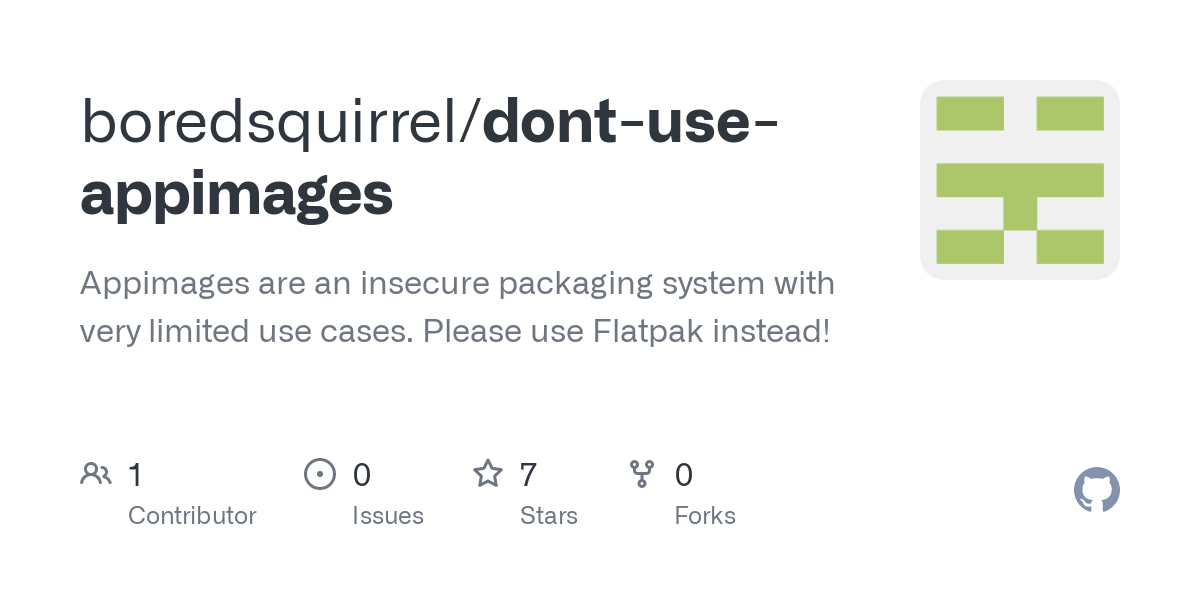Appimages totally suck, because many developers think they were a real packaging format and support them exclusively.
Their use case is tiny, and in 99% of cases Flatpak is just better.
I could not find a single post or article about all the problems they have, so I wrote this.
This is not about shaming open source contributors. But Appimages are obviously broken, pretty badly maintained, while organizations/companies like Balena, Nextcloud etc. don’t seem to get that.



AppImage is great at what it does - provide an ultra-low effort packaging solution for ad-hoc app distribution that enables a developer who won’t spend the time to do rpm/deb/flatpak packaging. There are obvious problems, security and otherwise, that arise if you try using it for a large software collection. But then again some people use things like Homebrew and pacstall unironically so …
Thank you for mentioning this! Unfortunately a quick search on the internet didn’t yield any pointers. Would you mind elaborating upon the security problems of Homebrew(/Linuxbrew)? Thanks in advance 😊!
Post about homebrew by Jorge Castro
I am not sure how secure it is.
I am aware that Homebrew has become the go-to solution for installing CLI applications on Bluefin. Which is exactly why I feel compelled to ask the question in my previous comment.
Btw, I don’t really understand why you felt the need to share Jorge Castro’s blog post on Homebrew? AFAIK it doesn’t go over any security implications. Sharing the article would only make sense if Jorge Castro is regarded as some authority that’s known to be non-conforming when security is concerned. While I haven’t seen any security related major mishaps from him or the projects he works on, the search for the CLI-counterpart to Flatpak seemed to be primarily motivated by facilitating (what I’d refer to as) ‘old habits’; which is exactly what Homebrew allows. It’s worth noting that, during the aforementioned search process, they’ve made the deliberate choice to rely on Wolfi (which is known for upholding some excellent security standards) rather than Alpine (which -in all fairness- has also been utilized by Jorge for boxkit). IIRC, people working on uBlue and related projects have even contributed to upstream (read Distrobox) for patches related to Wolfi. So, there’s reason to believe that the uBlue team takes security seriously enough to work, contribute and deliver on more secure alternatives as long as it doesn’t come with a price to be paid by convenience. Which, in all fairness, is IMO exactly why Homebrew is used for in the first place (besides their recent utilization of technologies that have similarities to the ‘uBlue-way’ of doing things)…
I’m not a security expert but I do know that the Homebrew is working with openssf on security: https://openssf.org/blog/2023/11/06/alpha-omega-grant-to-help-homebrew-reach-slsa-build-level-2/
Boxkit predates wolfi so it’s still alpine, I’ll probably replace it at some point but most of the forks of boxkit are because people want the premade github actions and they end up replacing it with whatever distro they want anyway. The wolfi connection is because I know the people who work there (including a ublue maintainer) and we have similar goals/ideas on how linux distros should be put together. My ideal dream is a wolfi userspace systemd-sysext on top of fedora base, then we can have our cake and eat it too!
We’re not security experts but lots of us work in the field and that gives us access to peer review from experts when we set things up. We sign every artifact with sigstore so users can verify that the code used in github is what’s on their image, that sort of thing. And most of our practices utilize CNCF governance templates that lots of other projects use.